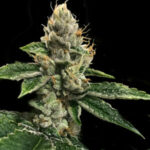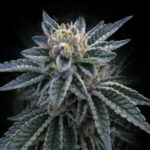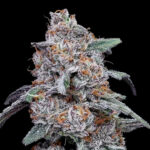FREE SHIPPING ON ORDERS OVER $100
Ultimate Guide for Choosing the Best Autoflower Light Cycles

Autoflower seeds have a unique growth pattern.
Unlike traditional cannabis seeds, autoflowers don’t wait for changes in light cycles to start flowering—they do it automatically after reaching a certain age.
But, just like any other plant, they need proper lighting.
Here arises the question: How much of it exactly?
The answer can be somewhat controversial, as ideal autoflower light cycles depend on specific growing circumstances.
This guide outlines everything you need to know to determine the perfect lighting conditions for your autoflowers.
Understanding Autoflowering Cannabis Seeds
First things first. Here are the most important aspects of autos.
What are Autoflowering Cannabis Seeds?
Autoflowering seeds develop into plants with a “built-in time tracker” that initiates flowering approximately five weeks after germination. These seeds combine genetics from sativa or indica cannabis with ruderalis, a strain originating from environments with cold climates and extended daylight periods.
As such, autos rely less on light cycles to initiate flowering—a trait cannabis breeders have embraced as a remarkable opportunity to expedite bud production.
Why are Light and Dark Cycles Important for Autoflowers?
Although autoflowers start flowering on their terms, they require light for photosynthesis—and lots of it—for healthy growth and rich yields.
Regarding darkness—opinions are divided.
Some growers swear their autoflowering plants thrive with dark periods, while others advocate continuous light cycles.
Which advice should you follow?
The best approach is to assess your specific strains and growing conditions and make the decision that fits your preferences.
The Best Autoflower Light Cycles
There are four commonly used autoflower light cycles.
| Light cycle | Description | Potential considerations |
| 12/12 | Ideal for growing photoperiods and autoflowers in the same tent, cost-effective | Yield and bud size may not reach full potential |
| 18/6 | Balances plant growth and rest, enables for larger yields than 12/12 | Lower yields than 20/4 |
| 20/4 | Mimics natural lighting conditions for autoflowers, potential for larger yields than 18/6 | Lower yields than 24/0, higher costs than 18/6 |
| 24/0 | Potential for faster growth and larger buds | May be harmful to some strains, the highest costs |
Below are the details of each.
12/12 Light Cycle
There are two types of cannabis seeds when it comes to flowering patterns: photoperiods and autoflowers.
Photoperiods are typically grown in a 12/12 light cycle during the flowering stage. This schedule can also be used for autos, and many growers apply it when growing both photoperiods and autoflowers in the same tent.
But, with autos, more light usually leads to bigger buds and richer yields. This means you can use a 12/12 light cycle for your autoflowers, although their buds may not reach their maximum size and quality.
Use the 12/12 cycle when…
- seeking to reduce electricity usage and save costs
- growing autoflowering and photoperiod plants together
- content with smaller buds
18/6 Light Cycle
Many growers agree that the 18/6 schedule is the most optimal autoflower light cycle.
It ensures plants receive sufficient light while allowing for rest during six hours of darkness. This is particularly important since autoflowers grow rapidly and have limited time to resolve developmental issues before flowering starts. 18/6 is also ideal for cultivating cannabis in hot climates, as it lets you switch off lights during the hottest part of the day, preventing heat buildup and plant stress.
Another benefit is that your electricity and lighting equipment can also “rest” in the dark periods, saving you money and resources.*
Use the 18/6 cycle when…
- growing autoflowering cannabis in hot climates
- willing to have a moderate electricity bill*
- aiming to prolong the lifespan of lighting equipment*
- wanting to maximize plant growth and allow adequate rest periods
*When compared with 20/4 and 24/0 cycles.
20/4 Light Cycle
Ruderalis originates from regions where the sun barely sets, making the 20/4 autoflower light cycle a reflection of this natural environment.
Similar to the 18/6 schedule, this method supplies plants with ample light for photosynthesis while allowing crucial rest periods. But, the 20/4 cycle consumes slightly more electrical energy than the 18/6 schedule, potentially resulting in higher bills.
Use the 18/6 cycle when…
- aiming to maximize plant growth
- willing to invest more in energy costs
- cultivating in cold climates or in an environment with advanced temperature control systems (note: this schedule may lead to overheating in regions with frequently high temperatures)
24/0 Light Cycle
Cannabis is a C3 plant, meaning it can continuously perform photosynthesis. This is the core principle behind the 24/0 approach—growers using it believe that since autos are C3 plants, they can thrive without any dark periods.
Another theory supporting the 24/0 cycle suggests increased light results in faster growth, larger buds, and higher yields.
While these claims may hold for some strains and circumstances, it’s also essential to know that, like everything else, autos may benefit from some time off to perform at their best. Some even argue that continuous light exposure can hinder autos’ development. Last but not least, running lights nonstop can significantly increase electricity costs and cause potential overheating of plants.
Use the 24/0 cycle when…
- content with a higher electricity bill
- seeking to accelerate the growing process
- growing autoflowering seeds in cold climates or a tent with precise temperature control
Optimal Light Spectrum for growing Autoflowering Cannabis Seeds
The vegetative and flowering phases of your autoflowering plants require specific optimal light spectra and temperatures.
| Development phase | Light spectrum range (nm) | Light temperature (K) |
| Vegetative | 400–500 | 6500 (blue light) |
| Flowering | 620–780 | 2700 (red light) |
Note: Although following these recommendations can greatly enhance your harvests, it’s entirely possible to achieve excellent results without them. But, of course, maximizing your efforts to support your plants is always advisable to ensure they reward you with abundant yields.
Aspects to Consider When Choosing an Autoflower Light Cycle
Here are some factors to help you make the best decision for your growth setup.
1. Budget
Budgeting is crucial in every aspect of cannabis cultivation. Running a 24/0 light cycle for a month can lead to significant electricity bills—and that’s on top of other regular costs. Fortunately, there are more cost-effective alternatives like the 12/12 and 18/6 schedules if you’re aiming to reduce costs.
2. Goal
There are typically two main goals in cannabis cultivation: personal use and commercial use. If you aim for the second, you want the maximum yields possible. In such cases, go with an 18/6, 20/4, or 24/0 cycle. If you’re growing for personal consumption and have budget constraints, the 12/12 light cycle can still provide decent yields, though slightly lower.
3. Space
The 12/12 schedule typically prevents autos from reaching their full potential, resulting in more compact sizes. This can benefit you if you’re growing in a limited space. For more spacious growing environments, options like 20/4 or 24/0 provide high potential for larger plants and yields.
4. Time
Longer light cycles, such as 20/4 or 24/0, demand more frequent maintenance and attention than shorter cycles. With longer cycles, you’ll likely need to monitor your plants more closely to ensure they receive the right amount of light and to adjust factors like humidity and temperature accordingly. That’s why it’s vital to consider your time and availability to care for the plants properly.
Top 4 Lighting Options for Growing Autoflower Seeds Indoors
Once you’ve settled on autoflower light cycles, it’s time to choose the lighting equipment.
Like with the light cycles, you should make the choice based on your preferences and growing circumstances.
Here’s an overview of the four most popular lighting options.
1. Fluorescent Lights (CFL)
C in the CFL stands for “Compact”, an attribute that describes what these lights are perfect for—compact, small grows.
They are often the most affordable lights and come with standard sockets compatible with any standard light fixture.
CFL bulbs are available in “daylight” versions, which produce blue light and are best for the vegetative phase, or “warm white” versions, which emit red light and are ideal for the flowering stage.
Approximate yield: 0.3g per watt.
2. High-Intensity Discharge Lights (HID)
HID lights, similar to those seen in sports stadiums or parking lots, are powerful light sources for your autoflowering plants.
If you opt for HIDs, you’ll essentially use two of their types: metal halide (MH) for the vegetation phase (emits blue light) and high-pressure sodium (HPS) for flowering (emits red light).
Approximate yield: 0.5–1.5g per watt.
3. Light Emitting Diodes (LED)
LEDs are all about energy efficiency and longevity. As such, they come with a higher initial price, but once you start using them, they truly live up to their promises.
High-quality models offer adjustable light spectrum settings, providing blue and red lights. This makes LEDs suitable for both vegetative and flowering stages.
Approximate yield: 0.5g–1.9g per watt.
4. Light Emitting Ceramic (LEC)
LEC lights emit natural-colored light and typically have a long lifespan. They also emit UV-B rays, potentially enhancing trichome production in your autoflowers.
Like other lighting options, you can adjust your LECs to emit either blue or red light spectra to match the specific stages of your plants’ growth cycles.
But not everything about them is perfect. In fact, their UV-B light may be harmful to human health. That’s why, when handling your plants under LEC lights, it’s essential to use appropriate safety equipment to protect yourself from potential skin damage.
Approximate yield: 1.5–1.8g per watt.
Ideal Autoflower Light Cycles for Growing Outdoors
Determining the perfect lighting cycles becomes much simpler when growing your autos outdoors.
The main reason?
Natural sunlight.
Nothing compares to mother nature’s source of light. This means you’ll likely achieve abundant yields regardless of the light cycle you follow. Of course, the rule “more light = more buds” also applies here.
Plant your autoflowers during the three sunniest months of the year in your region for maximum yields.
5 Expert Tips for Growing Autoflowering Cannabis
Maximizing your autoflower yields can be simple. Here are top tips from our experience to help you get the most out of your plants.
- Opt for high-quality autoflower seeds.
- Choose a light and airy growing medium, such as coco coir or perlite, to promote healthy root development.
- Apply an 18/6 light schedule during the initial seed growth stages to ensure gradual light exposure.
- Avoid over-fertilizing, as autoflowering strains usually need fewer nutrients than photoperiods.
- Stick to low-stress techniques when training your plants.
Which Autoflower Light Cycle is Right for You?
The right autoflower light cycle is unique for each grower—it’s the one that aligns with your specific growing conditions and your strain’s needs.
What is universal about autoflower seeds is their simplicity and speed in delivering high-quality yields. They are remarkably resilient and thrive in a wide range of environments.
But if you’re just starting, we suggest beginning with 18/6 or 20/4. These cycles are popular among growers, deliver reliable results, and allow you to become familiar with the plant. We also encourage you to experiment with different light schedules to find the one that works for you.
Whether growing indoors or outdoors, it’s crucial to select autoflower seeds with proven genetics that yield greatly and develop into plants with potent effects.
Find them in DNA Genetics—explore our premium autoflower seeds collection.
FAQs
- What is the best light cycle for growing autoflowers outdoors?
Many growers have different preferences, but it’s widely agreed that autoflowers thrive with 18 to 24 hours of light daily throughout their lifecycle. A 20/4 light schedule—20 hours of light followed by 4 hours of darkness—is frequently viewed as the optimal lighting cycle.
- Do autoflowering strains need periods of darkness in their growth cycle?
Technically no. Autos can grow under any light schedule. But the general recommendation is to provide them with at least a few hours of darkness to rest and allow their hormones to undergo regenerative processes.
- Can I change autoflower light cycles while plants are growing?
Yes. Autoflower seeds and plants don’t mind changes in light cycles as long as they receive at least 12 hours of light.
- Can my autoflowers get too much light?
Yes, some autoflower strains can be sensitive to excessive light. It’s best to consult with your seed providers or start with less intensive schedules, such as 16/8, to avoid potential issues.
- What are the signs of autoflowers getting too much light?
Check the plants’ leaves. If you notice them curling upwards, your autos are likely receiving too much light.
SHARE THIS POST WITH YOUR FRIENDS
About OG DNA Genetics Inc.
DNA Genetics was rooted in Los Angeles and founded in Amsterdam in 2004 by Don Morris and Aaron Yarkoni. Over the last decade, the Company has built and curated a seasoned genetic library and developed proven standard operating procedures for genetic selection, breeding, and cultivation. In a world that is increasingly opening up to commercial cannabis activity, DNA is positioned to become the first, truly geographically-diversified company with multiple partnerships with top-licensed producers and brands that have built their companies and global presence utilizing the “Powered by DNA” model.
FOR FURTHER INFORMATION PLEASE CONTACT the following:
Rezwan Khan ([email protected]) – President for DNA Genetics
LEGAL DISCLAIMER: THIS WEBSITE SHOULD NOT BE VISITED BY ANYONE UNDER THE AGE OF 21. PLEASE DO NOT ASK QUESTIONS ON HOW TO GROW OR SMOKE ANY DNA GENETICS PRODUCTS AS UNDER CURRENT LEGISLATION IT IS ILLEGAL TO GROW OR ENCOURAGE THROUGH GIVING ADVICE ONLINE. FOR INFORMATION REGARDING DNA GENETICS CANNABIS SEEDS PLEASE DIRECT YOURSELF TO OUR EUROPEAN STORE. ANY INFORMATION, MARKETING MATERIAL OR WEBSITES, IS GIVEN FOR THE EDUCATIONAL PURPOSE OR PURPOSE OF DIFFERENTIATION. IT IS NOT INTENDED TO CONDONE, PROMOTE OR INCITE THE USE OF ILLEGAL OR CONTROLLED SUBSTANCES.

 Bruce Banner Fast Version Cannabis Seeds
Bruce Banner Fast Version Cannabis Seeds



